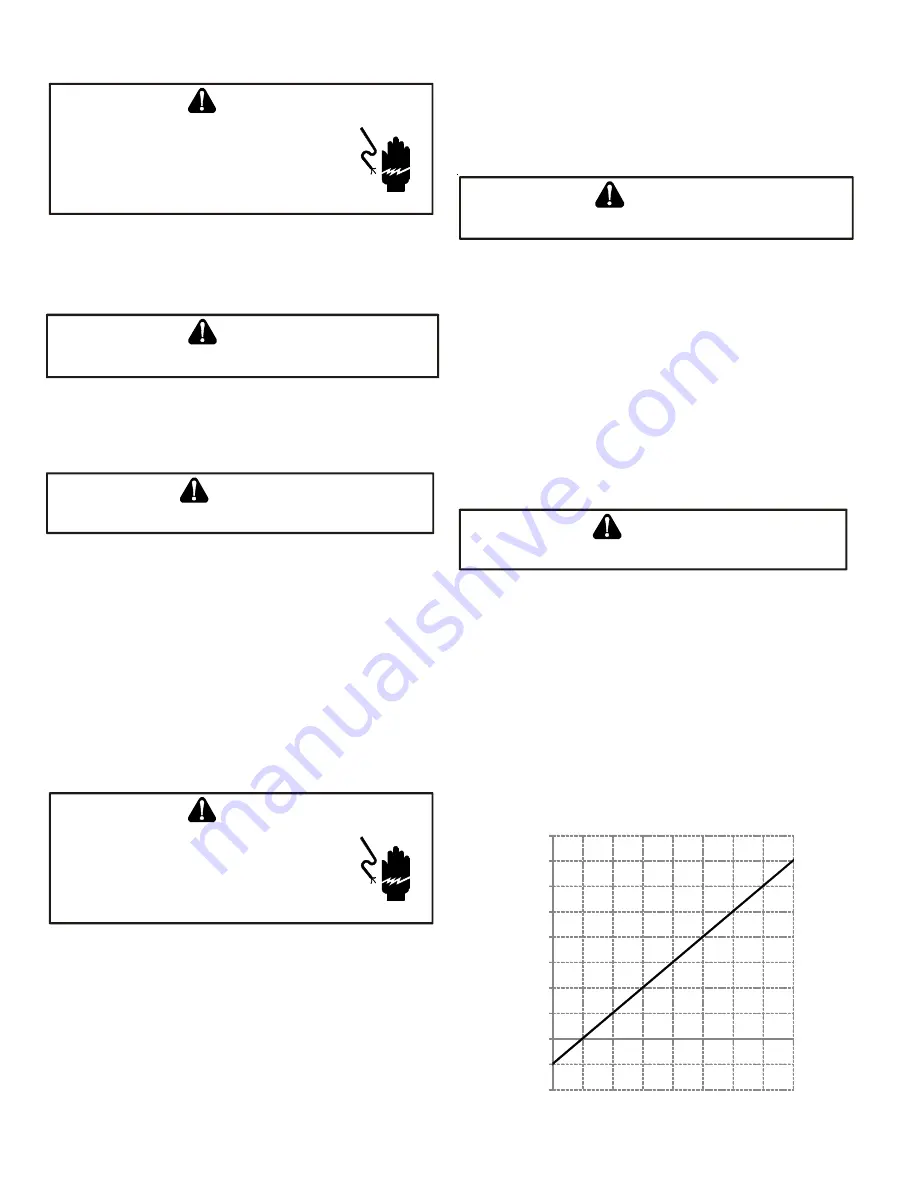
SERVICING
36
S-4 CHECKING TRANSFORMER AND CONTROL CIRCUIT
HIGH VOLTAGE !
D
ISCONNECT
ALL
POWER
BEFORE
SERVICING
OR
INSTALLING
. M
ULTIPLE
POWER
SOURCES
MAY
BE
PRESENT
. F
AILURE
TO
DO
SO
MAY
CAUSE
PROPERTY
DAMAGE
,
PERSONAL
INJURY
OR
DEATH
.
WARNING
A step-down transformer (208/230 volt primary to 24 volt second-
ary) is provided with each indoor unit. This allows ample capac-
ity for use with resistance heaters. The outdoor sections do not
contain a transformer (see indoor unit WIRING DIAGRAM).
D
ISCONNECT
ALL
POWER
BEFORE
SERVICING
.
WARNING
1. Remove control panel cover, or etc., to gain access to trans-
former.
With power ON:
L
INE
V
OLTAGE
NOW
PRESENT
.
WARNING
2. Using a voltmeter, check voltage across secondary voltage
side of transformer (R to C).
3. No voltage indicates faulty transformer, bad wiring, or bad
splices.
4. Check transformer primary voltage at incoming line voltage
connections and/or splices.
5 If line voltage available at primary voltage side of transformer
and wiring and splices good, transformer is inoperative. Re-
place.
S-12 CHECKING HIGH PRESSURE CONTROL SWITCH
HIGH VOLTAGE !
D
ISCONNECT
ALL
POWER
BEFORE
SERVICING
OR
INSTALLING
. M
ULTIPLE
POWER
SOURCES
MAY
BE
PRESENT
. F
AILURE
TO
DO
SO
MAY
CAUSE
PROPERTY
DAMAGE
,
PERSONAL
INJURY
OR
DEATH
.
WARNING
The high pressure control switch senses the pressure in the com-
pressor discharge line. If abnormally high condensing pressures
develop, the contacts of the control open, breaking the control
circuit before the compressor motor overloads. This control is
automatically reset.
1. Using an ohmmeter, check across terminals of high pressure
control, with wire removed. If not continuous, the contacts
are open.
2. Attach a gauge to the dill valve port on the base valve.
With power ON:
L
INE
V
OLTAGE
NOW
PRESENT
.
WARNING
3. Start the system in charge mode and place a piece of card-
board in front of the outdoor coil, raising the condensing
pressure.
4. Check pressure at which the high pressure control cuts-out.
If it cuts-out at 605 PSIG to -17 PSIG, it is operating normally
(See causes for high head pressure in Cooling/Heating Analy-
sis Chart). If it cuts out below this pressure range, replace the
control.
S-13 CHECKING INDOOR AND OUTDOOR HI/LOW PRES-
SURE SENSOR
With Power ON:
L
INE
V
OLTAGE
NOW
PRESENT
.
WARNING
1. Connect a bar gauge manifold to the heat pump unit
2. Connect a pair of extended Molex probe tips to your voltmeter
test leads.
3. Find the suction pressure in the cool mode, or discharge
pressure in the heat mode. (bar gauge manifold) Connect a
DC voltmeter across sensor terminals 1 and 3, (black and
white wires) and record the DC voltage.
4. Compare your readings to the detected pressure vs output
voltage in the following table. Replace the sensor if the sensor
is open, shorted, or outside of the voltage range.
-200
-100
0
100
200
300
400
500
600
700
800
0.0
0.5
1.0
1.5
2.0
2.5
3.0
3.5
4.0
De
te
ct
ed
P
ress
u
re
(P
SIG
)
Output Voltage (DCV)
















































